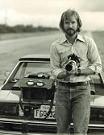Wayne:
You mentioned that you thought you never saw Mel again after the Laredo race. After Mary died at the race, and Mel arrived back home, within a just a few days he was in the hospital. Was there for several weeks and he also passed away. I never heard the official cause of death, but everyone said it was a "broken heart". He and Mary were married for many years and very close.


 Thanks:
Thanks:  Likes:
Likes: 









Bookmarks